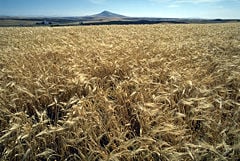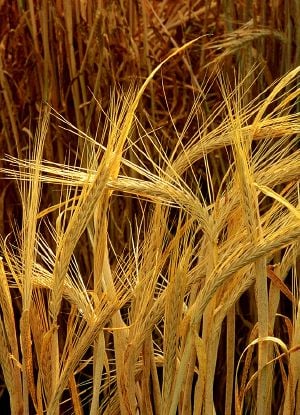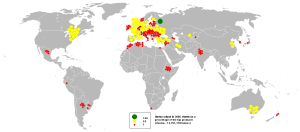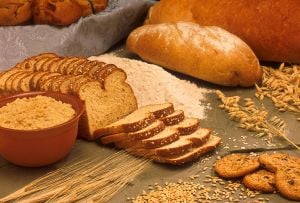Barley
| Barley | ||||||||||||||
|---|---|---|---|---|---|---|---|---|---|---|---|---|---|---|
 Barley field
| ||||||||||||||
| Scientific classification | ||||||||||||||
| ||||||||||||||
| Hordeum vulgare L. |
Barley (Hordeum vulgare) is an annual cereal grain, which is used as a major animal feed crop, as a popular spice, in malting and in health food. Barley ranks fourth among the cereals in terms of total world production (BarleyWorld 2006). Barley is a very good source of fiber, selenium, phosphorus, copper and manganese. It is a member of the grass family Poaceae (Gramineae), which also includes rice, wheat, and maize.
Description
Barley is one of the most important and widely consumed cereals produced in the world. It was one of the first crops domesticated for human consumption and can grow in a large number of environmental conditions. Today it is useful to people all over the world, most importantly in animal fodder, in brewing beer (when it is malted), and to a less extent in human foodstuffs.
The scientific name for barley is Hordeum vulgare L.There are many varieties of barley, all of which can be classified as either a spring or winter type. Winter types require a cold period in order produce flowers and set seeds, and they are planted in the fall. Spring types do not require this cold period, and for best production they are planted as early in spring as the soil allows. When the reproductive phase is reached, the stems elongate and the flowering head (also referred to as the spike or ear) extends upward. The fertile florets on the flowering head contain both male and female reproductive structures; thus, barley primarily self-pollinates. Barley varieties can also be classified according to the number of kernel heads, which determines the fertility of the florets on the plant (see Cultivars below).
The height of a barley plant averages roughly eighty centimeters, though it can vary greatly.
Composition
The composition of barley, omitting the salts, is as follows:
| Water | 15% |
| Nitrogenous compounds | 12.981% |
| Gum | 6.744% |
| Sugar | 3.2% |
| Starch | 59.95% |
| Fat | 2.17% |
Cultivars
Barley can also be classified as six-rowed, four-rowed, or two-rowed, referring to the number of kernal rows in the head. This determines the fertility of the florets on the spike (the spike is the structure containing the flowers and later the mature seeds). In six-rowed barleys (traditionally known as Hordeum vulgare) and four-rowed (Hordeum tetrastichum), all of the florets are fertile. In contrast, in two-rowed types (Hordeum distichum) only the central floret of the three at each node is fertile, and thus just two rows of seeds develop on opposite sides of the rachis (central stem).
Barley can be divided by the number of kernel rows in the head. Three forms have been cultivated; two-row barley (traditionally known as Hordeum distichum), four-row (Hordeum tetrastichum) and six-row barley (). In two-row barley only one spikelet is fertile; in the four-row and six-row forms, all three are fertile.
Two-row barley is the oldest form, wild barley being a member of this category. Two-row barley has a lower protein content and higher starch content than six-row barley. High protein barley is best suited for animal feed or malt that will be used to make beers with a large adjunct content (those which lack enzymes). Two-row barley is traditionally used in English ale-style beers and traditional German beers, whereas six-row barley is common in some American lager style beers. Four-row is unsuitable for brewing.
Barley is widely adaptable and is currently a major crop of the temperate and tropical areas. It is likely to be susceptible to barley mild mosaic bymovirus as well as Bacterial blight (Brunt et al 1996).
History of Production
Domesticated barley (H. vulgare) is descended from wild barley (Hordeum spontaneum). Both forms are diploid (having two sets of chromosomes, one maternal and one paternal). As wild barley is interfertile with domesticated barley, the two forms are often treated as one species, divided into Hordeum vulgare subsp. spontaneum (wild) and subsp. vulgare (domesticated). The main difference between the two forms is the brittle rachis (main stem) of the former, which enables seed dispersal in the wild. The earliest finds of wild barley come from Epi-Paleolithic sites in the Levant, beginning in the Natufian. The earliest domesticated barley occurs at Aceramic Neolithic sites in the Near East such as the Pre-Pottery Neolithic B (PPN B) layers of Tell Abu Hureyra in Syria. Barley was one of the first crops domesticated in the Near East, along with einkorn and emmer wheat.
Barley was, alongside emmer wheat, a staple cereal of ancient Egypt, where it was used to make bread and beer; together, these often comprised a complete diet. The general name for barley is jt (hypothetically pronounced "eat"); šma (hypothetically pronounced "SHE-ma") refers to Upper Egyptian barley and is a symbol of Upper Egypt. According to Deuteronomy 8:8, barley is one of the "Seven Species" of crops that characterize the fertility of the Promised Land of Canaan, and barley has a prominent role in the Israelite sacrificial cult described in the Pentateuch (see e.g. Numbers 5:15).
In ancient Greece, the ritual significance of barley possibly dates back to the earliest stages of the Eleusinian Mysteries. The preparatory kykeon or mixed drink of the initiates, prepared from barley and herbs, was referred to in the Homeric hymn to Demeter, who was also called "Barley-mother".
| jt barley determinative/ideogram |
| ||||
| jt (common) spelling |
| ||||
| šma determinative/ideogram |
|
Greek practice was to dry the barley groats (whole grains with the husks removed) and roast them before preparing the porridge, according to Pliny the Elder's Natural History (xviii.72). This produces malt that soon ferments and becomes slightly alcoholic.
Tibetan barley has been the only major staple food in Tibet for centuries. It is made into a flour product called tsampa.
Palaeoethnobotanists have found that barley has been grown in the Korean Peninsula since the Early Mumun Pottery Period (c. 1500–850 B.C.E.) along with other crops such as millet, wheat, and legumes (Crawford and Lee 2003).
Modern Production
| Top Ten Barley Producers — 2005 (million metric ton) | |
|---|---|
| 16.7 | |
| Canada | 12.1 |
| 11.7 | |
| 10.4 | |
| Ukraine | 9.3 |
| 9.0 | |
| 6.6 | |
| 5.5 | |
| 4.6 | |
| 4.4 | |
| World Total | 138 |
| Source: UN Food & Agriculture Organization (FAO)[1] | |
Barley was grown in about 100 countries worldwide in 2005. The world production in 1974 was 148,818,870 tons, showing little change in the amount of barley produced worldwide.
Uses
Half of the world's barley production is used as an animal feed. A large part of the remainder used for malting and is a key ingredient in beer and whiskey production. Non-alcoholic drinks such as barley water and mugicha are also made from unhulled barley. Barely is also used in soups and stews, particularly in Eastern Europe. A small amount is used in health foods.
Barley is more tolerant of soil salinity than wheat, which might explain the increase of barley cultivation on Mesopotamia from the second millennium B.C.E. onwards. Barley can still thrive in conditions that are too cold even for rye.
Barley must have its fibrous outer hull removed before it can be eaten. Barley grains with their hulls still on are called covered barley. Once the grain has had the inedible hull removed, it is called hulled barley. At this stage, the grain still has its bran and germ, which are nutritious. Hulled barley is considered a whole grain, and is a popular health food. Pearl barley or pearled barley is hulled barley which has been processed further to remove the bran. It may be polished, a process known as "pearling".
Hulled or pearl barley may be processed into a variety of barley products, including flour, flakes similar to oatmeal, and grits. It may be malted and used in the production of alcoholic beverages.
ReferencesISBN links support NWE through referral fees
- BarleyWorld.org. 2006. What Is Barley?. Oregon State University. Retrieved July 30, 2007.
- Bender, D. A., and A. E. Bender. 2005. A Dictionary of Food and Nutrition. New York: Oxford University Press. ISBN 0198609612.
- Brunt, A.A., Crabtree, K., Dallwitz, M.J., Gibbs, A.J., Watson, L. and Zurcher, E.J. (eds.) 1996. Plant Viruses Online. CAB International. Retrieved August 10, 2005.
- Crawford, Gary W. and Gyoung-Ah Lee, "Agricultural Origins in the Korean Peninsula," Antiquity 77(295):87–95, 2003.
- Herbst, S. T. 2001. The New Food Lover's Companion: Comprehensive Definitions of Nearly 6,000 Food, Drink, and Culinary Terms. Barron's Cooking Guide. Hauppauge, NY: Barron's Educational Series. ISBN 0764112589
- Katz, S. H., and W. W. Weaver. 2003. Encyclopedia of Food and Culture. New York: Schribner. ISBN 0684805685.
External links
- Barley as a commodity traded in India
- Genetically modified barley Aim: Resistant barley with improved malting and fodder qualities
Credits
New World Encyclopedia writers and editors rewrote and completed the Wikipedia article in accordance with New World Encyclopedia standards. This article abides by terms of the Creative Commons CC-by-sa 3.0 License (CC-by-sa), which may be used and disseminated with proper attribution. Credit is due under the terms of this license that can reference both the New World Encyclopedia contributors and the selfless volunteer contributors of the Wikimedia Foundation. To cite this article click here for a list of acceptable citing formats.The history of earlier contributions by wikipedians is accessible to researchers here:
The history of this article since it was imported to New World Encyclopedia:
Note: Some restrictions may apply to use of individual images which are separately licensed.
- ↑ Food and Agriculture Organization. 2007. Barley Production. United Nations. Retrieved August 10, 2005.


